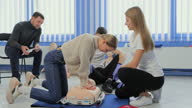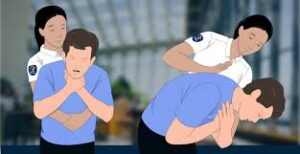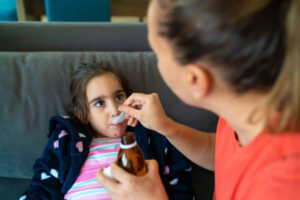In Case of EMERGENCY First Aid Methods/Techniques
In emergency situations, it is important to remain calm and call for professional medical help immediately. While waiting for help to arrive, there are several first aid techniques that can be used to help save a person’s life.
- Cardiopulmonary Resuscitation (CPR): CPR is a lifesaving technique used to restart a person’s heart if they have gone into cardiac arrest. It involves chest compressions and rescue breathing.
- Choking First Aid: If a person is choking, stand behind them and give them 5 sharp back blows between their shoulder blades with the heel of your hand. If this does not work, give them 5 abdominal thrusts.
- Control bleeding: To control bleeding, apply direct pressure to the wound with a clean, dry cloth. If the bleeding is severe, elevate the wound above the heart and apply pressure with both hands.
- Shock: If a person is in shock, lay them down and elevate their feet about 12 inches. Keep them warm and monitor their breathing and pulse.
- Burns: For minor burns, cool the burn with water for 20 minutes, and cover it with a clean, dry dressing. For more severe burns, call for professional medical help immediately.
- Fractures: If a bone is suspected to be broken, immobilize the area and call for professional medical help immediately.
- Poisoning: If a person has been poisoned, call for professional medical help immediately and follow any instructions given.
It’s imperative to note that these are the basic first aid techniques, but it’s always better to get trained by a professional in First Aid.
CPR Explained
You can significantly reduce your risk of dying from a heart attack and serious heart damage by administering basic first aid. When the heart does not receive enough oxygen, a (myocardial infarction) ensues. The heart muscle dies when there is not enough oxygen.
Experiencing nausea or vomiting
“White as a ghost” in appearance (very pale)
Started to get a cold sweat.
Emotions of fear or gloom
Back, shoulder, arm, neck, and jaw aches or pains
Unsteadiness or fainting
A state of weakness or unusual exhaustion
Cardiopulmonary resuscitation (CPR) is a lifesaving technique that is used to restart a person’s heart if they have gone into cardiac arrest. It is a combination of chest compressions and rescue breathing that helps to circulate oxygen-rich blood to the brain and other vital organs.
Step 1: Check for Responsiveness: Before starting CPR, make sure the person is unresponsive by tapping their shoulder and asking “Are you okay?” If the person does not respond, call for professional medical help immediately.
Step 2: Position the Person: Position the person on their back on a firm surface. Kneel down beside them and extend your arms, so that your hands are positioned on the person’s chest.
Step 3: Start Chest Compressions: Place the heel of your hand on the person’s breastbone, which is the flat bone in the centre of the chest. Place your other hand on top of the first hand and interlock your fingers. Press down on the person’s chest with your hands, using your upper body weight to compress the chest about 2 inches. Release the pressure and allow the chest to rise. Repeat the compressions at a rate of 100 to 120 per minute.


Step 5: Continue CPR: Alternate 30 chest compressions with 2 rescue breaths until professional medical help arrives or the person starts to regain consciousness.
It’s important to note that the American Heart Association (AHA) updated the CPR guidelines in 2020, which recommends performing compression-only CPR in case of bystanders are not trained in CPR or are not comfortable providing rescue breathing.
It’s very important to get trained by a professional in CPR, as the proper technique and timing of compressions and ventilation are vital to saving a person’s life.
Detailed Technique for Choking First Aid

Choking occurs when a foreign object becomes lodged in a person’s airway, blocking their ability to breathe. It is a medical emergency that requires immediate attention. If a person is choking, you can use the following technique to help dislodge the object and restore their ability to breathe:


Step 1: Check for Responsiveness: Before starting first aid, make sure the person is choking by tapping their shoulder and asking “Are you okay?” If the person is choking and unable to speak, call for professional medical help immediately.
Step 2: Stand Behind the Person: Stand behind the person who is choking, so you can give them back blows.
Step 3: Give Back Blows: Give the person five sharp back blows between their shoulder blades with the heel of your hand. This should help to dislodge the object and restore its ability to breathe.
Step 4: Give Abdominal Thrusts: If the back blows do not work, give the person five abdominal thrusts. To do this, stand behind the person and place your hands just above their navel. Clasp your hands together and give a quick upward thrust. This should help to dislodge the object and restore its ability to breathe.
Step 5: Repeat: Repeat the sequence of back blows and abdominal thrusts until the object is dislodged or the person becomes unconscious.
Step 6: Call for Professional Medical Help: If the person becomes unconscious, lower them to the ground and begin CPR.
It’s very important to note that if you are not trained in this technique, you should only perform back blows, as the abdominal thrusts can cause injury if not done properly.
It’s always better to get trained by a professional in choking first aid, as the right technique and timing are vital to saving a person’s life.
Burns First Aid Techniques for Boiling Water, Milk, Acid or Iron
Burns are injuries to the skin caused by heat, chemicals, electricity, or radiation. The severity of a burn can range from mild to severe, and different types of burns require different first aid techniques. Here are detailed first-aid techniques for treating burns caused by boiling water, milk, acid, and iron:
- Boiling Water Burns:
- Remove the person from the source of heat and cool the burn immediately with cool water for at least 20 minutes.
- Remove any clothing or jewellery near the burn, as they can retain heat and cause further injury.
- Cover the burn with a sterile, non-adhesive dressing or a clean, dry cloth.
- Seek medical attention immediately, especially if the burn is deep or covers a large area of the body.
- Milk Burn:
- Same as boiling water burn, remove the person from the source of heat and cool the burn immediately with cool water for at least 20 minutes.
- Remove any clothing or jewellery near the burn, as they can retain heat and cause further injury.
- Clean the burn with soap and water.
- Cover the burn with a sterile, non-adhesive dressing or a clean, dry cloth.
- Seek medical attention immediately, especially if the burn is deep or covers a large area of the body.
- Acid Burn:
- Remove the person from the source of acid and flush the burn with cool water for at least 20 minutes.
- Remove any clothing or jewellery that has been contaminated with acid.
- Do not apply any ointment, butter or cream on the burn, as they can trap the acid against the skin and cause further injury.
- Cover the burn with a sterile, non-adhesive dressing or a clean, dry cloth.
- Seek medical attention immediately, especially if the burn is deep or covers a large area of the body.
- Iron Burn:
- Remove the person from the source of heat and cool the burn immediately with cool water for at least 20 minutes.
- Remove any clothing or jewellery near the burn, as they can retain heat and cause further injury.
- Clean the burn with soap and water.
- Cover the burn with a sterile, non-adhesive dressing or a clean, dry cloth.
- Seek medical attention immediately, especially if the burn is deep or covers a large area of the body.
It’s important to note that in all cases, any burn that covers a large area of the body, involves the face, hands, feet, or genitals, or is deeper than the top layer of skin should be treated as a medical emergency and professional medical help should be sought immediately.
It’s important to note that in all cases, any burn that covers a large area of the body, involves the face, hands, feet, or genitals, or is deeper than the top layer of skin should be treated as a medical emergency and professional medical help should be sought immediately.
Lifesaving chances increase through the provision of timely first aid till the arrival of media care help in emergencies
Timely first aid can greatly increase a person’s chances of survival in an emergency situation. Immediate first aid can help to stabilize a person’s condition and prevent further injury or deterioration until professional medical help arrives.
For example, in the case of cardiac arrest, every minute without CPR decreases the chances of survival by about 10%. Once CPR is started and continued until professional medical help arrives, it can increase the chances of survival by as much as 50%.
In the case of severe bleeding, the application of direct pressure to the wound can help to slow or stop the bleeding, which can prevent shock and death.
In case of choking, if a person is choking, timely first aid can help to dislodge the object and restore the ability to breathe.
In case of burns, timely first aid can help to reduce pain, prevent infection, and minimize scarring.
In case of fractures, immobilization of the area can help to prevent further injury and reduce pain.
In case of poisoning, seeking professional medical help immediately can help to prevent further injury or death.
It’s important to note that providing timely first aid is not a substitute for professional medical care, but it can greatly increase a person’s chances of survival and recovery in an emergency situation.
Overall, providing timely first aid can be a crucial step in saving a person’s life and preventing further injury until professional medical help arrives.
First Aid Kit to be kept in the House Office or a Vehicle
A first aid kit is a collection of supplies and equipment that can be used to provide immediate medical assistance in case of an emergency. Here is a list of items that should be included in a basic first-aid kit:
- Adhesive bandages of various sizes for cuts and scrapes
- Antiseptic wipes or solution for cleaning wounds
- Tweezers for removing splinters or other small foreign objects
- Scissors for cutting clothing or bandages
- Safety pins for holding dressings or splints in place
- Disposable gloves to protect yourself and others from bodily fluids
- Thermometer
- Pain relievers such as acetaminophen or ibuprofen
- A breathing barrier mask with a one-way valve for performing rescue breathing
- An instant cold pack
- Sterile gauze pads and adhesive tape for covering wounds
- A CPR face shield
- A first aid manual
For a vehicle, it’s important to have a first aid kit that is specifically designed for use in a car. It should include items such as a flashlight, a warning triangle, and a reflective vest.
For a house or office, you may want to include additional supplies such as a snake bite kit, a splint, and a tourniquet.
It’s important to note that some items such as medications, ointments and creams have expiration dates and it’s important to regularly check and replace expired items in the first aid kit.
It’s also important to note that these are the basic items that should be included in a first aid kit, but additional items may be added based on personal needs or specific situations.


